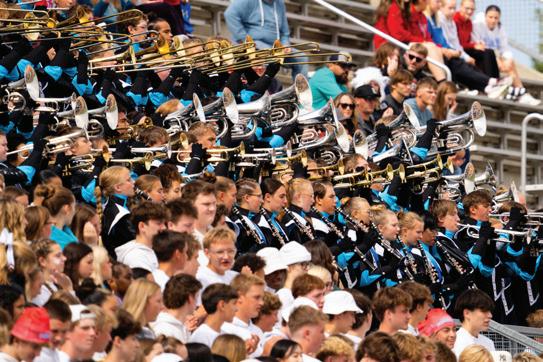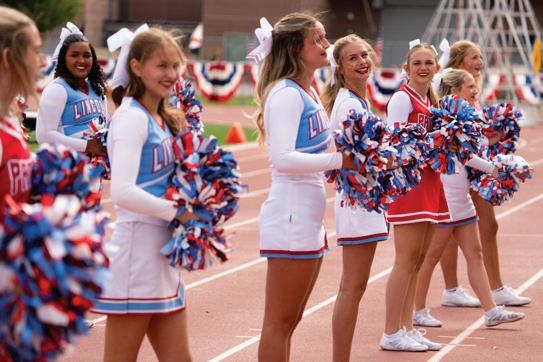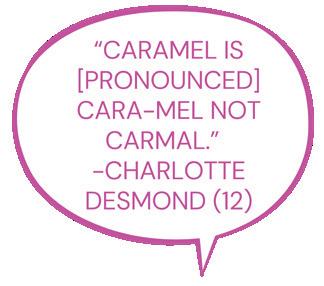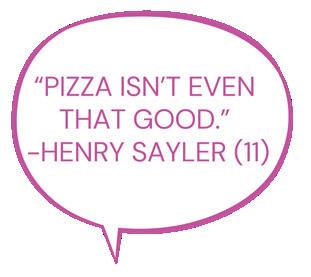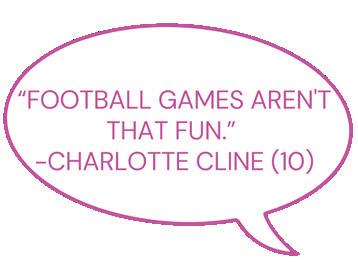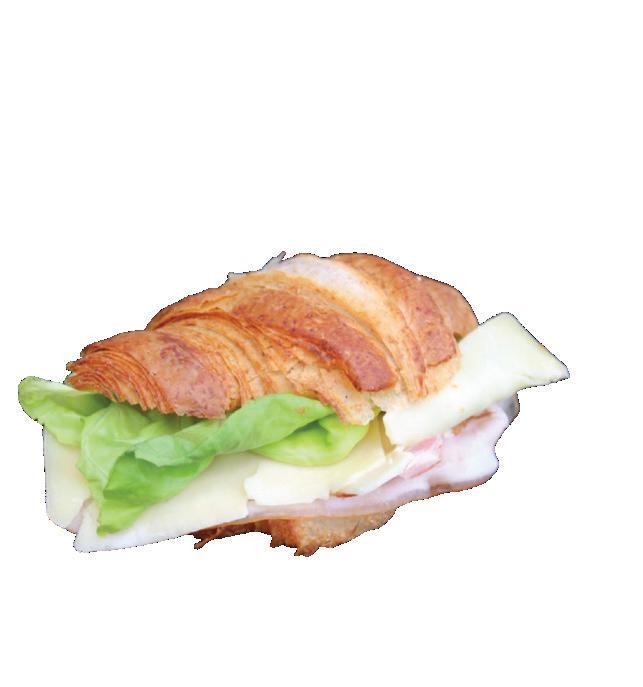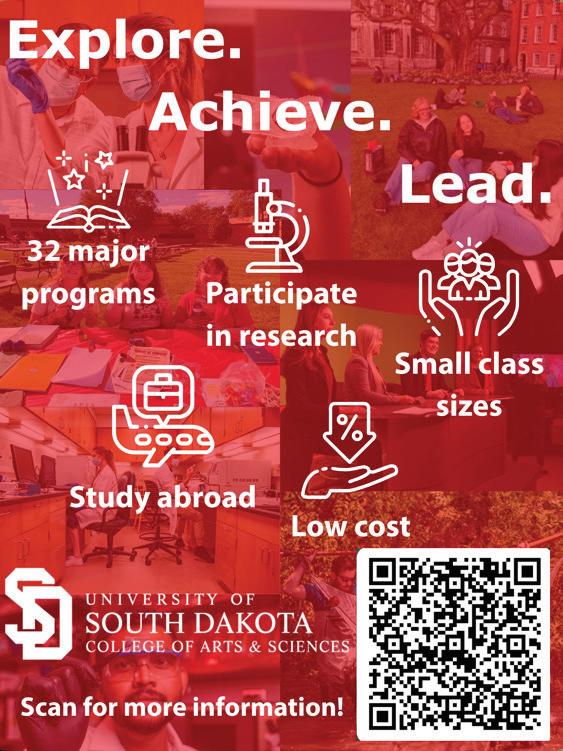






Julia
Ellie
Dena
Berkeley
Ingrid
Alice
Ellie
Bethany


Kinsley
Isabel
Nadia





Paper Editors-In-Chief: Eloise Geraets, Naomi Jespersen, Vivian Kiesow-Knudsen, Ellie Quinn
Online Editors-In-Chief: Nadia Schneider, Chris Tao
News Editors: Sam Barnett, Logan Sanborn
Feature Editors: Kinsley Ernster, Berkeley Newell
Entertainment Editors: Ellie Boehrns, Dena Tarrell
Sports Editors: John Quello, Jacob Wessels
Perspectives Editors: Will Hansen, Bethany Jespersen
Photography Editor: Mason Dean
Social Media Coordinators: Lucy Hennies, Bethel Woche
Staff Writers: Alice Geraets, Isabel Gillespie, Julia Hedrick, Hazel Hughes, Lily Osmundson, Soranje Phenias, Ruby Hennies, Quinton Hollan, Alonso Ramirez, Trey Raph, Ingrid Ready, Will Van Schepen, Khloe Dillman, Brielle Kolling, Ava Thompson
Adviser: Dr. Katie Kroeze

An opportunity for highschoolers to jump-start on college credit just got a little more expensive.
In the state of South Dakota, roughly 30% of high school juniors and seniors will enroll in a dual-credit course at some point in their high school career. Last year, this accounted for 5,739 participants statewide. However, under changes made during South Dakota’s most recent legislative session, the state has reduced its contribution to a subsidized rate for high schoolers — shifting a higher percentage of the cost onto students and families.
Dual-credit courses give high school juniors and seniors the opportunity to earn college credit while simultaneously working toward their high school graduation requirements. Along with offering them the ability to experience college-level coursework, the program can also help to reduce the time and cost of completing a post-secondary degree.
“It’s an opportunity for students to really go in-depth on certain programs,” said Dianna Miller, a lobbyist for the Large School Group. “They have a jump-start on credits for when they decide to further their education.”
In terms of cost, students pay just a fraction of the standard price. Undergraduate tuition is set at approximately $266.60 per credit hour across South Dakota Universities. Dualcredit courses are offered at a lowered rate of $156.90, as set by the South Dakota Board of Regents. Prior to the 2025 legislative session, the State of South Dakota split this remaining cost with students, covering an additional two-thirds of the already subsidized rate. Altogether, participating high schoolers paid $48.33 per credit hour.
However, legislation was introduced at the beginning of this year that would reduce the state’s contribution to a 50-50 split. This increased the cost to $78.48 per credit hour. In total, this price increase will save the state approximately $1.2 million annually.
This bill (House Bill 1040) represents just one focus of a broader push by the state to reduce spending.
“The budget was in a deficit situation, and we had to look at all the departments,” said South Dakota Secretary of Education Joseph Graves. “We were trying to find a way to not impact the schools negatively and still save the
design by ViVian Kiesow-Knudsen
money that the state needs to save.”
According to Graves, all state departments were asked to offer up cuts — the Department of Education among them. Along with the dual-credit program, it extended cuts to both the State Library and a state mentoring program.
“Certainly, we could have protected any one particular program and taken it out of another one, but we were trying to protect the school budgets because that’s what impacts the students the most,” said Graves.
In any case, this wave of cuts sparked opposition after South Dakota ended its fiscal year with a $63 million surplus. While a majority (two-thirds) of this money came from unanticipated unclaimed property revenue, the rest was a result of this reduced spending within state departments. Opponents to the cuts argued that they were overly aggressive and neglected necessary state programs.
Graves said that this conservative spending model — in line with South Dakota’s constitutional requirement for a structurally balanced budget — is what keeps the state out of debt.
House Bill 1040 (HB 1040) specifically addressed the dual-credit cost split and



by ViVian Kiesow-Knudsen, editor-in-ChieF
was introduced on Jan. 14. It was at this point that the Sioux Falls School District became aware of the proposed increase. The bill then passed through the House and Senate, where it was initially rejected by the Senate Education Committee on a 4-3 vote. It was later revived, passed through the Senate, and eventually signed by Governor Larry Rhoden on March 19.
During this process, the bill was subject to significant criticism as some groups were concerned with the program’s accessibility following the price increase.
According to Graves, the dual-credit program — widely considered to be very successful — was actually chosen as a focus because of its popularity and reputation.
“We knew that people would pursue it even if there was a difference in the [split],” Graves said.
Graves added that, while there was significant opposition from legislators to cutting back on such a beloved
program, the cuts were a difficult but necessary decision in terms of budget.
Representing the interests of large South Dakota public school districts, Miller was among the group in opposition to HB 1040.
“I think this is an area that the state could have looked elsewhere,” said Miller. “The Constitution requires we balance our budget. I don’t think using this program to try to do that was a good idea. When you increase the cost, that might prohibit some kids from participating because their parents can’t afford to pay the additional amount.”
Miller and her fellow lobbyists plan to monitor over the coming year and may attempt to reintroduce it during the next legislative session. She said she considers the 50-50 split a “loss” and encourages students and families to address the matter with their legislators.
“I think that we have to wait and see
what happens with the program,” said Miller. “I don’t want to make a statement that we won’t lose the momentum. I’m thrilled that we have a lot of participation in dual-credit. That’s fantastic. Why wouldn’t we want to try to continue to have that momentum and increase it?”
With the cost increase, students in need of financial assistance should visit with their counselor.
“The Sioux Falls School District, along with community partners, provides and will continue to provide financial support to students who qualify for assistance with dual-credit costs,” said SFSD High School Curriculum Coordinator Kristin Grinager.
“If we’re going to make an investment in South Dakota, the best place to make an investment is in the young people coming up that will soon be governing this state,” said Miller. “That’s a big investment for me.”


by Naomi JesperseN & Chris Tao, ediTors-iN-Chief
Following his inauguration at the beginning of 2025, President Donald J. Trump signed numerous executive orders directed towards immigration enforcement. Within 50 days of the Trump Administration in office, Immigration and Customs Enforcement (ICE) made more than 32,000 arrests, exceeding the total arrests that took place in half of the previous year, according to the Department of Homeland Security (DHS).
In conjunction with these national trends, South Dakota launched its own statewide initiative directing human and financial resources towards immigration enforcement. Piloted by Governor Larry Rhoden in the summer of 2025, Operation Prairie Thunder is a dual initiative designed to address both crime and illegal immigration. Within Sioux Falls, the operation’s primary focus is “to interdict drugs, investigate gang activity, hold parole absconders accountable and deter lawlessness,” according to News.SD.Gov.
The secondary focus of Operation Prairie Thunder is statewide immigration enforcement made possible by two separate 287(g) agreements between state and federal law enforcement.
The first collaboration, between the South Dakota Department of Corrections (DOC) and ICE is categorized as the 287(g) Jail Enforcement Model, which gives DOC employees the power to interrogate, detain and transport illegal immigrants who are already in custody.
The second collaboration, considered the 287(g) Task Force Model agreement, was made between the South Dakota Highway Patrol and ICE. Under this partnership, the Highway Patrol can question and process any persons suspected of being in the U.S. illegally during routine activities like traffic stops.
“Under the 287(g) program, a limited number of troopers receive training to handle situations where they may encounter individuals suspected of being in the country illegally during the normal course of their duties,” said the South Dakota Department of Public Safety, which declined to be interviewed.
Since the ratification of these
agreements — and the subsequent launch of Operation Prairie Thunder — there has been increased discussion about immigration enforcement and operations within Sioux Falls. Although the Sioux Falls Police Department (SFPD) is participating in the first aim of Operation Prairie Thunder — centered around decreasing gang activity and drug crimes — it is not involved in the signing of any 287(g) agreements with ICE.
throughout the city, particularly in Hispanic and immigrant communities.
“We've been very, very scared. We usually don’t go out, especially since I work in a public space, and I interact with a lot of Hispanics,” said one LHS student. “It's been really slow, and [many Hispanics] really don't want to go out and do their normal activities.”
for Peace. “The narrative of the administration, both on a federal level and on a state level, that they’re picking up [only] violent criminals is false … and it's provable by the people who have been detained so far.”
This mixed messaging from all levels of government about the aims and actions of ICE in South Dakota contributes to the fear present throughout Sioux Falls communities.
“[The] Sioux Falls Police lanes,” said Thum. “Our primary goal and purpose is to serve and protect and promote quality of life for the people of Sioux Falls.”
For this student, South Dakota’s increased emphasis on immigration enforcement has also sparked

When referring to the people of Sioux Falls, Thum means all people, regardless of their immigration status.
“If you were a victim of a crime, we don't care what your immigration status is. That's not our job. It's not our purview,” said Thum. “We simply don't ask [for immigration status], and we have no authority within that hemisphere.”
Despite the SFPD’s uninvolvement in immigration enforcement, fear is still prevalent
“If I go back to [redacted], I … don't have a house. I don't have anywhere to go,” said the student. “Some conversations with my mom will be like, ‘Well, if we get deported, we need to go to your grandma's house. We need to see if
“It's really important to understand what the community hears. It doesn't matter what is fact or fiction because if they're scared [and] believe something's happening, that's what's going to dictate how they move around Sioux Falls, and there's obviously a lot of fear,” said Islam.
For Islam, combatting that fear through open communication with Hispanic communities is a major goal, yet she believes the heart of the immigration issue is much deeper than legislation or dialogue.
“The real issue is not what's legal and what's illegal. [We need to ask], ‘what are the economic drivers that are bringing people into our country in an unlawful way and why are we not creating lawful ways for them to do that?’” said Islam.
Although arrest and deportation can not be carried out by the SFPD, the 287(g) Task Force Model Agreement gives the Highway Patrol “the power and authority to interrogate any alien or person believed to be an alien as to his right to be or remain in the United States.” Furthermore, the agreement grants “the power and authority to arrest without a warrant any alien” if the Highway Patrol officer believes the individual is in the U.S. illegally. Already, these powers have been used throughout the state in cities such as Madison, where the Highway Patrol assisted in detaining eight men in a worksite enforcement initiative in May.
“There was a raid in Madison back in May, and I met with those guys when they were detained here in Minnehaha County Jail because I wanted to know firsthand what happened and what was going on,” said Taneeza Islam, a community activist, attorney and Executive Director of South Dakota Voices
As for the City of Sioux Falls and the SFPD, both continually clarify that they have no immigration jurisdiction, and their actions in Operation Prairie Thunder are not related to the immigration enforcement aspect.
“[Operation Prairie Thunder] was not well-rolled out,” said Sioux Falls Mayor Paul TenHaken. “[It] was not communicated well when it was launched. When people keep asking me questions, I keep sending it to the state, saying, ‘this is not my deal.’ They need to clarify all these things.”
For the LHS student, the Highway Patrol’s immigration powers, as well as South Dakota’s unclear messaging, are not only anxiety-inducing, they are troubling.
“I feel like they're generalizing that all immigrants are criminals, which is not true,” said the student. “We're hard-working people, and we're just here to get a better opportunity that we didn't have in our home countries.”

by Julia Hedrick
Have you ever wondered who is behind the sports live streams or the eye-catching graphics at LHS?
While most students at LHS scroll through their course options, they might think they know all the usual suspects: AP Chem, yoga, journalism, maybe even a cooking class or two. But hidden quietly in the school’s curriculum is an unknown gem: Sports Broadcasting, Marketing and Video Production class. This class offers realworld job preparation, offering a wide variety in the broadcasting department.
“Our Sports Broadcasting, Marketing and Video Production class is different from other classes at LHS. In the class, we cover everything that goes into producing a game day and live sports event. We handle the live streams for home games, do playby-play and color commentary, run cameras, play music during games and create graphics and animations for the video board,” said Charnelle Wooledge.
live-streaming sporting events, and more. Students in the class can expect an average amount of work, mostly hands-on tasks. Some of the assignments include pregame and postgame stories and writeups, as well as creating animations and graphics for video boards.
available to all grade levels.
“I took the class because it looked interesting and I thought it was going to be a cool class,” said sophomore Kalen Karlen. “The class is chill, and you get to learn a lot of new stuff.”

Additionally, I assist with compiling and playing music playlists during games.
Taught by Wooledge, Sports Broadcasting, Marketing and Video Production class is a class where students learn real-world experience in sports media, game day, and video production, all while having fun. In the class, students are responsible for creating game day graphics,
“My students create many of the social media graphics that fans see before game day, and we come up with our own crowd engagement ideas like ‘Make Some Noise’ or ‘Let’s Go Patriots!’ They are excited when they get to see their work displayed,” said Wooledge.
There is currently one period of Sports Broadcasting, Marketing and Video Production class, with 12 students enrolled. It is offered as a full-year class as well as a semester,
“One of the coolest things about sports broadcasting is that everything we do is live. Students have to think fast and work as a team. It’s also exciting to hear your voice on the livestream or see your graphic on the video board in front of a crowd and on the message boards at school,” said Wooledge. If someone loves sports or working behind the camera, Sports Broadcasting, Marketing and Video Production class might be the perfect class for them. It is the perfect chance to learn real-world skills, be a part of your school’s media team while bringing creative ideas to life.
If you are interested in taking the class or want to learn more, reach out to Wooledge or your counselor to see how you can get involved. You can follow the class by following their Facebook under “Patriot Broadcasting” or on Instagram @sf_patslive.




by ElliE Quinn, Editor-in-ChiEf

Clay. Starting as a sketch, it is molded into ceramic pieces representing everyday life and aesthetic amusement.
LHS visual arts teacher Travis Hinton takes his passion beyond the classroom and into his personal life. What evolved from an overcrowded workspace in undergraduate school at USD has turned into a personal business selling his artwork to spaces across the United States.
While Hinton has not yet sold his work beyond national borders, his work has touched patrons globally.
“I have only shipped within the United States. One of the galleries that represents my work told me that they shipped one of my pieces to Paris, France. I do know that I have my artwork in other countries. The ones that come to mind are Qatar, Japan and recently Portugal,” said Hinton.
Being a working artist takes effort. One of the hardest aspects of the business is the marketing and selfpromotion required to build up a

community of buyers. Marketing his work is a tedious task but is required to reach the success Hinton has achieved thus far.
“I would rather be creating. When I am in my studio, my focus is on solving and constructing my artwork. When I am exhibiting my artwork, the focus shifts to answering questions that come from patrons,” said Hinton.
Though there are more challenges beyond creating and selling, pricing the art is one more hurdle Hinton makes the most of.
“The artist and the art market assert the value of their work,” said Hinton.
The final step of the process, making the sale, is one that is reassuring for Hinton and his talents. His goal of selling his artwork has been reached confidently many times over the years.
“I have sold individual pieces, groupings of pieces and complete dinnerware sets. [All] have had comparable price tags. I don’t share specific prices, but it was in the thousands and definitely a moment that affirmed the value others see in my work,” said Hinton.
Like any other activity outside of school or work, Hinton finds a necessary balance between working at LHS and with his pottery, which can be difficult at times. But operating in the studio takes many different forms depending on the day and availability in Hinton’s schedule.
“Balancing family, teaching and being an artist takes work. I try
to work in the studio as much as possible. That could look like physically working on a piece of artwork, sketching out ideas or researching raw materials that I use,” said Hinton.
Researching materials and knowing every detail about the mediums he uses is something Hinton has been interested in since his first experience with clay. Most of the materials he uses can be locally sourced.
“When I first touched clay, I knew that I wanted to know all I could about the material,” said Hinton. “I work with a local distributor here in Sioux Falls; they have most of what I need. I also use some native clay materials.”
As he expresses different periods of ceramics and with dual purposes in mind, Hinton’s friends and family encourage his artistry.

“I draw inspiration from classic or traditional functional ceramic forms. I like the duality of my work being used in everyday life and appreciated aesthetically,” said Hinton.
by Dena Tarrell
Planes, bombs and pounding footsteps were common sounds for the 3.1 million American soldiers stationed in Vietnam. Of those soldiers, 58,279 of them did not make it home. That would be the last sounds they heard. But one small town South Dakota boy ensured that was not the case for the soldiers around him.
Michael J. Fitzmaurice was born on March 9, 1950, in Jamestown, ND, where his parents were on a trip. After he was born, his parents took him home to South Dakota. He then spent the entirety of his childhood in Cavour, SD. Shortly after he graduated high school, he enlisted in the military, where he served from 1969-1972. After enlisting, he was later deployed to Vietnam to fight in the Vietnam War.
The Vietnam War began in 1954, during the Cold War era. Communism was becoming more popular in Western Asia and eventually spread towards Vietnam. North Vietnam was pushing for communism in the country, but South Vietnam was opposed. The U.S. allied with South Vietnam to help in the fight against communism.
On March 23, 1972, shortly after his 21st birthday, Fitzmaurice came face-
to-face with North Vietnam soldiers, one of the main enemies in the war. In the heart of battle, death and tragedy were all around him, yet he remained determined and steadfast. When he and the other soldiers in his squadron were in their bunker, the opposing enemies launched three grenades towards them. Fitzmaurice successfully threw the first two grenades out of the bunker, but the third was not as easy. Without a moment of hesitation, he jumped on top of the grenade, smothering the explosion and saving the lives of those around him. He sustained severe injuries, such as shrapnel wounds, an injured eye and burst eardrums, yet he continued on, refusing medical attention. At the time, he was wearing a flak vest, which was the reason he was able to survive.
“When it’s all happening you… just do, you don’t think about it,” said Fitzmaurice.
After Fitzmaurice was discharged from the war, he was taken to Fitzsimons Army Medical Center in Colorado, where his wounds were finally treated. When he recovered, he returned to South Dakota and began working
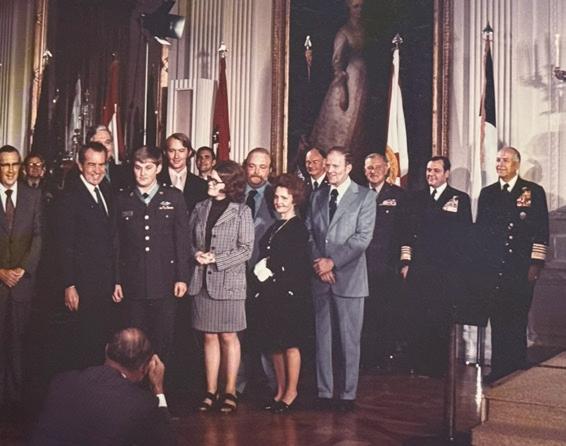

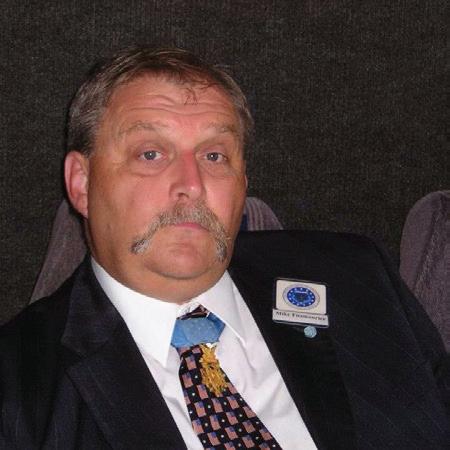

in a packing house in Huron, SD. Two years after he was discharged, he got a phone call. He had been chosen to receive the Medal of Honor and Purple Heart for his heroic actions during the war. When he returned home, he shared the news with his parents and wife. To receive his medals, he traveled to Washington, D.C. with his family, where there was a ceremony for the five recipients at the time. At the ceremony there were eyewitnesses to corroborate his and the other recipients’ actions. Fitzmaurice met and shook hands with President Richard Nixon, who chose Fitzmaurice as a Medal of Honor recipient. While in D.C. Fitzmaurice had a personal escort and photographer everywhere he went. He wined and dined with the president and many other high-standing figures. The hotel he stayed at was upscale, and his room was a suite. It is safe to say that only the best was provided for these war heroes.
“[Receiving the medal] was pretty exciting for a little boy from South Dakota,” said Fitzmaurice. Since receiving the Medal of Honor, Fitzmaurice has traveled all over the country, meeting numerous presidents such as George H.W. Bush, George W. Bush, Bill Clinton and Barack Obama. He also regularly meets with other Medal of Honor recipients. Every year, there is a national convention where they can be surrounded by people who have
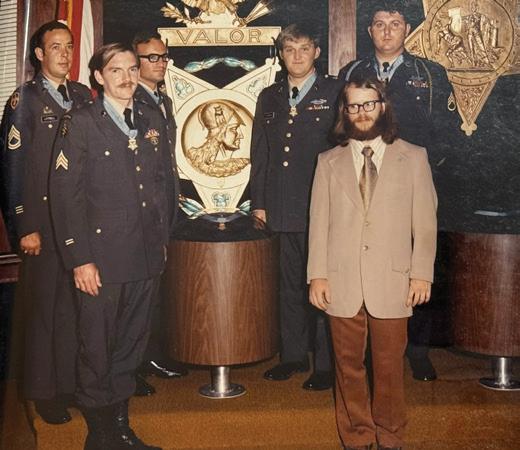
similar experiences, providing comfort and solace. This year’s convention was held in Chattanooga, TN.
Nothing could have prepared Fitzmaurice for the events that would occur during his time in the Army. No training could ever compare to what he would have to do. Yet, he acted on instinct and managed to save the lives of the soldiers in his squadron. It was not only him that saved lives, though. Fitzmaurice worked with the other soldiers, and together they fought against the common enemy. His brave actions put him above and beyond the rest, but he does not want to take all the credit. He does not want the medal to only be for him; he wants to share it with everyone else who fought.
Joining the Army is the first brave action soldiers take. Defending others is the next. Some get the recognition they deserve, and some do not, but all are heroes in history.
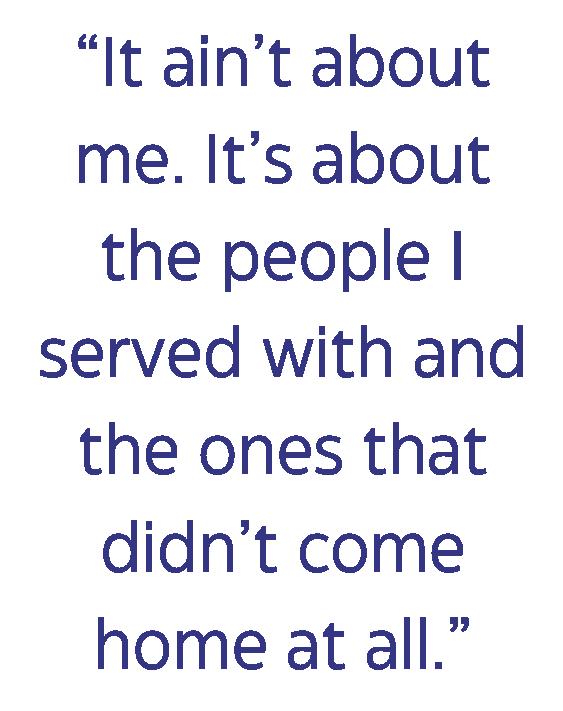



Twoto five percent of the general population are terrified of being above the ground in any capacity. For LHS junior Alahna Noble, however, flying through the skies is a part of her life, albeit a slightly abnormal aspect.
“It’s so cool to just get a perspective that nobody else really can see on a daily basis,” said Noble.
Having the opportunity to copilot planes is not exactly a typical experience for the average 16-year-old. However, growing up surrounded by planes and aviation, mainly because of her father, who is a former military and currently commercial pilot, it was never very out-of-the-ordinary for Noble.
“I remember him coming home [from work] and I’d be like, ‘So where did you go? What did you do?’” said Noble. “And I was always so interested in how fast the jets went.”
Despite constant exposure to the world of aviation, Noble never considered flying planes as something she wanted to do until about a year ago, when she flew in a plane with her dad and one of his friends, who has a hangar near the Sioux Falls Regional Airport. Noble went into the flight expecting to be relegated to the backseat while the two men flew when she was met with an interesting proposition.
“They were like, ‘Hey, you want to hop in the front seat and start?’ And I was like, ‘Sure,’” said Noble. “It was very random, very spontaneous, but I was like, ‘Oh. I could see myself doing this.’ I’ve always had just kind of a… need for speed. So, it was kind of fun to be like, ‘Oh my gosh, I’m in actual control of something that isn’t just a car.’”
Her excitement certainly did not stop her there. Following her first flight, Noble began pursuing her private pilot solo license, which will allow her to take the plane up without an instructor in the copilot’s seat. The licensing process is tedious and time-consuming, as it requires a minimum of 40 hours of flight time and a 70% or higher on a 60-question knowledge test. For Noble, balancing school, her numerous other activities and flying is what causes the average six month learning program to take a bit longer.
“I haven’t started a lot of the study work for it. I’m just building up some ground base hours and getting comfortable with the gadgets and all the areas and tools and everything that are in the planes,” said Noble. “I was planning on sitting down and buckling in with it [when I turned 16], but time
kind of flew by and I [got caught up in other stuff].”
For Noble, however, the actual act of flight is more exhilarating and fulfilling than the tedious piloting study work.
“I’m just kind of doing it as a hobby right now. I definitely am transferring more towards aviation job wise, [for that] field of work, because I definitely know that with that there are many opportunities for me. I’ve never really sat down and thought about what I really want to do… [but] the aviation aspect as a whole has definitely opened up and it’s like, ‘Oh, wow. I could do this,’” said Noble.
There are so many intriguing aspects of being up in the atmosphere, but nothing is more awe-inspiring than the bird’s eye view.
“[My favorite part is] right after we kind of lift up from the runway, because I like… the climbing altitude. I like seeing ground level and everything get smaller and smaller,” said Noble. “Honestly, I really like just being up and being able to see Sioux Falls.”
Flying a plane also comes with many challenges, in part because it is so different from operating any other vehicle. From the steering to the many additional tasks pilots have to complete while in flight, Noble had many new components and tasks to get used to when she began flying.
“It’s not like driving; it’s something that has way more components, which is honestly something I didn’t really think about or figure out until I was actually in the driver’s seat or a copilot seat,” said Noble. “[The weirdest thing is that] when you’re taxiing right before you get off the runway, you steer [the rudders] with your feet… there’s times where I reach for [the yoke (steering wheel)] and I’m trying to turn and it doesn’t work because that’s for the wings. It’s almost like walking; it’s really weird.”
Despite the difficulties and learning curves, flying and the experiences that Noble has had have given her a new perspective on life and learning.
“It’s not honestly even just the destination for me. It’s the process of getting there, too, [and] just the whole journey from start to end. And honestly for me, there is no definite end because I’m always kind of moving along. So, it’s just the journey, and you kind of see where [that] takes you,” said Noble.
Flying planes is certainly not an everyday activity for the average person, and some people may even see it as terrifying or dangerous, but by taking chances and pursuing what one loves, one can never go wrong.
“[My advice is] just take the opportunities,” said Noble. “You never know where you’re gonna end up. I mean, life’s a journey and flying’s a journey from even takeoff to landing. So, just kind of enjoy it and take the opportunities that you can… because you never know; you might end up loving it. And it opens up so many more doors than you think it will.”
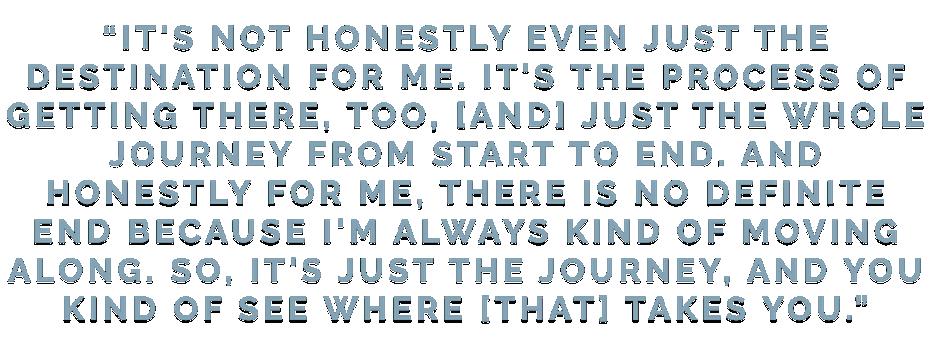


by IngrId ready
What do you think it takes to be a leader? Do you think leaders are born or can they be developed through experience and teachings?
The Lincoln Leaders Council was developed this year by David Maxwell, the athletic director at LHS. The council consists of small groups of students chosen by their coaches or directors from 37 different LHS activities. These activities consist of athletics, music, fine arts and some other extracurriculars. There will be eight meetings held in the 2025-26 school year. During these meetings they will talk about many different topics, such as how a person wants people to see them and what they are doing to be perceived that way, the qualities it takes to be a good leader and many other concepts.
Maxwell made this council in order to create a safe space where different sports and extracurriculars would allow student voice within the activities department at LHS. It was made as an opportunity for students to provide input on different ideas, or to talk about what they think should be happening at LHS.
“[I wanted to] provide the space for a group for me to be able to go to if I have ideas on something that I’d like to bounce the ideas off of our student body. I don’t ever want it to feel like the activities office is just making decisions without considering the students in all that we’re doing,” said Maxwell.
This is also an opportunity for Maxwell to talk about district level issues and get feedback from the students about how it affects them, then go back to the district and tell them what the ideas students created.
“I 100% believe that you can develop leaders. And this is an opportunity for us to help develop leaders in our school and talk about different leadership qualities and traits,” said Maxwell.
Being a leader by example can be developed, and Maxwell believes that the four C’s, commitment, confidence, composure and character, are the qualities someone should have in order to be a leader. There are also two more qualities that go into being a vocal leader which are being an encourager and being an enforcer.
“I think as far as traits of being a leader, I think you have to be a great communicator with people. I think you have to be consistent. And when I say consistent, meaning the people in your program or, quite frankly, how you show up every day in your life. They have to know what they’re going to get from you on a daily basis,” said Maxwell.

Many people have the fundamental idea of how someone is just born a leader, but Maxwell thinks that leaders can be developed; that is why he made this council.
To Maxwell, being consistent means showing up with the same attitude every day.
Someone cannot show up one day and be positive and an encourager, then show up the next day with an attitude and be snarky with their teammates.
Lincoln Leaders Council allows for Maxwell to get more student interaction and sit down to talk to students about concerns they have, so he can try and help with those issues.
“Some people may respond to [you being] extremely direct and maybe raising your voice and some of those things, and that’s how you get the best out of people, and others might need you to put your arm around them and tell them and communicate with them in a different way,” said Maxwell. Someone needs to know how to be a leader when their teammates are doing something wrong or need help with an issue. Some people may be more sensitive than others, so that person has to know how their teammates will respond to how they will confront them about the issue.
The Lincoln Leaders Council was created to help students become leaders and improve leadership skills. It shows the qualities that are important and hopefully will change the leadership culture of LHS in the future.
“No matter what we did today, that doesn’t matter anymore when we show up tomorrow.

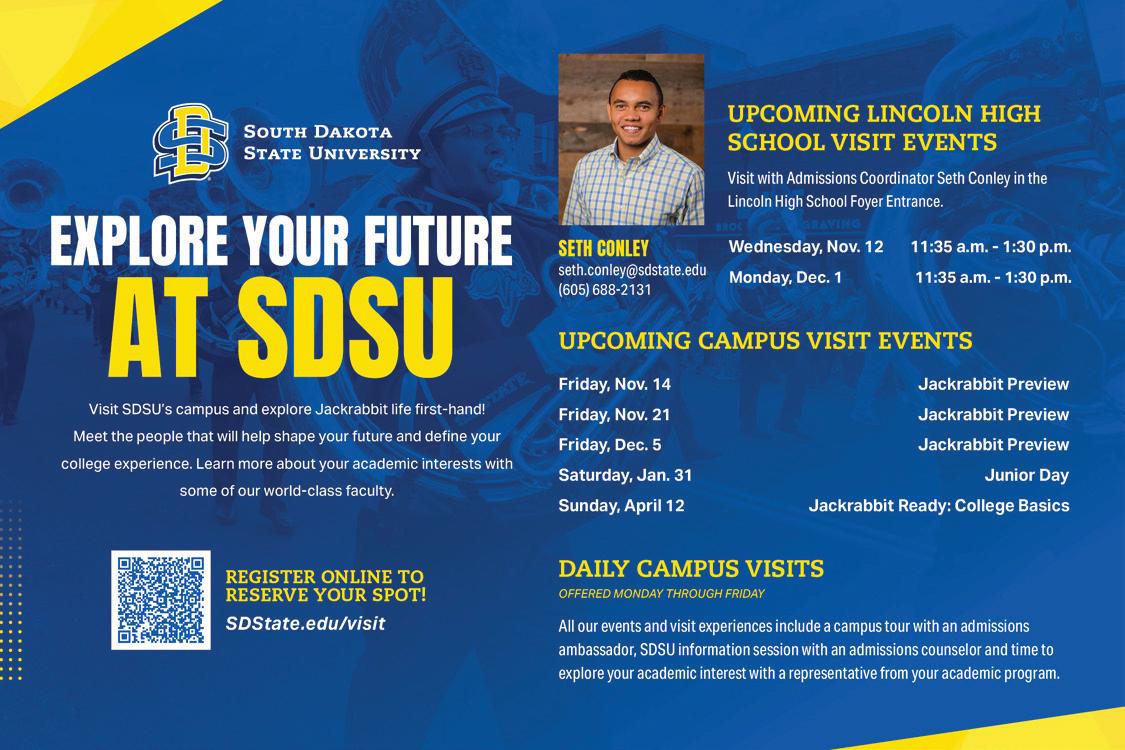
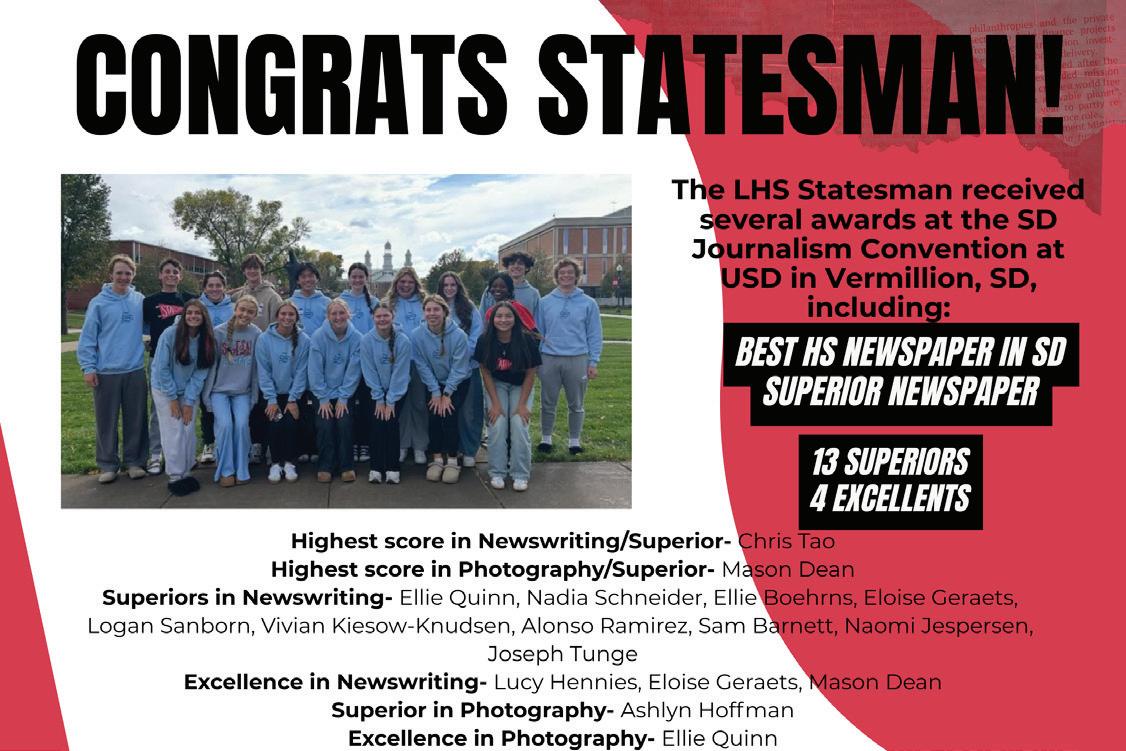



by Alice GerAets
Musicstudents all around South Dakota have a chance to audition into a select group known as All-State. This year, the All-State orchestra and choir concert were held on Nov. 1 at the PREMIER Center. There is an immense amount of preparation that goes into the audition alone.
Orchestra students begin their preparation for their audition in the spring of the previous year with a binder of music. When they are auditioning, the judge may pick any passage from this binder, and they must know how to play it proficiently, students also must prepare a solo piece. Once the student completes their playing audition, they take a terms test that is 100 questions. All-State orchestra takes a lot of preparation. One of the LHS faculty members who helps with all that is Kimberly Bogart, the orchestra teacher.
“These guys are really going above and beyond when you choose to audition because it is a big commitment,” said Bogart.
This is Bogart’s first year with the LHS orchestra, but that is not stopping her from helping the students be as prepared for their audition as they can. During the summer, Bogart held prep sessions for students to come and get extra help with their music. To audition for All-State, students must put in hours of practice. One orchestra student in particular has been a part of AllState three years in a row and will be auditioning again this year: Giyun Seo. He is a senior at LHS who has been playing the violin for 10 years. He prepares for his
audition by running through the music and focusing on harder parts that he most likely will be asked to play.
“I listen to music to get a sense of style, speed, rhythm and just to know how everything is supposed to sound,” said Seo.
Choir students start their preparation at the beginning of the school year. Kathy Ferguson and Mike Bossman are the choir teachers here at LHS. Every year, Ferguson will choose a song they will sing in their audition. Students will also have to sing the Patriotic, “My Country ‘Tis of Thee” or “America the Beautiful,” in addition to the combined piece. This year the piece that Ferguson chose was “America the Beautiful” arranged by Darmon Meader. For choir students to be able to audition, they must be in Concert choir, which is the choir with the highest-level singers at LHS and is an auditioned choir.
This year, there were an equal number of altos and sopranos who auditioned, while the tenors and basses were fewer. The students that chose to audition sang in a quartet of soprano, alto, tenor and base; these groups are randomly chosen to ensure everything is fair.
“They have to literally know what they are doing because they have to be able to sing it with any person in the choir,” said Ferguson.
Molly Leuning, an LHS senior, is a Concert Choir student who has been in All-State for one year and will be returning again for her second year. Leuning practices not only the music, but also how she will look while she is singing.

“I practice in front of a mirror just to know what I look like when I am auditioning,” said Leuning.
She also takes voice lessons, so she will work with her voice teacher who gives her critiques on what she can do to make her even better. Leuning enjoys All-State because it gives her a chance to connect with other kids all around the state.
All-State takes a lot of preparation that can go unnoticed. Although not everyone makes it into this group of musicians, they still choose to put in the work to get better because they want to. All-State is an amazing opportunity for students all around the state to come together and do something they all love and to appreciate all the hard work they put in.
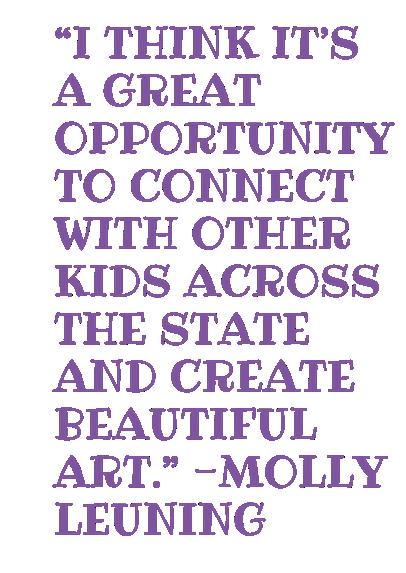




a discipline to purify the body, mind and spirit.
While being a Hindu practice, many western cultures have taken part of the physical aspect and have classes or clubs based around it at schools, including LHS.
Yoga club at LHS takes place every other Friday at 3:30 p.m. to 3:45 p.m. in room E117, or in the JROTC room during the winter months. The club is run by LHS sophomores Sasha McAdaragh, Cecilia (Ceci) Peters, Ophelia RidoutNorris and Ellie Tinguely and is advised by Physical Education and Health Teacher, Kaaren Huber. They help lead meditation, as well as partner yoga, where two or more people support and work together in poses and yoga flows. Yoga flows are followed in a continuous stream that helps with breathing synchronization.
“Leading the class is really fun,” said McAdaragh. “[So is] having another knowledge and [...] it’s just an easy way to exercise.”
LHS provides a yoga class taught by Huber, which is beginner-friendly and takes students through poses and yoga flows step-by-step. Yoga is generally considered a form of exercise with its use of strength, cardio and balance; but it has uses outside of just exercise. When executing yoga poses and flows, people stretch their bodies and gain more flexibility, helping prevent injuries in activities or everyday life. Yoga also helps with range of motion in both the joints and muscles.
“If you are in any dance things, then you do get stretched and you make sure you are not injuring yourself,” said Peters.
While exercising the body, yoga also helps calm and clear the mind of stress. When someone is present and in the moment, their poses tend to be stronger, but when someone is mentally elsewhere, they tend to struggle with balance and fall out of poses. This is because they are focusing on the past or their aura has been disrupted, and the student lets their surroundings affect them. Aura, in yoga terms, is an energy field that surrounds the body, reflecting emotional, mental and spiritual state.
by ElliE boEhrns
But breathing exercises and meditation along with yoga poses help many learn how to breathe properly and control themselves when emotions are heightened.
“You can control [a stressed aura] internally by breathing and positive thoughts,” said Huber. “[You are] able to see the quiet confidence that yoga’s providing.”
With its fun, no-judgement and easy-going environment, many members look forward to yoga club meetings to learn about yoga, meet new people, have fun and get to know each other, all with a snack provided. There is no sign up and no pressure to come to all meetings.
“I always look forward to it throughout the day,” said RidoutNorris.

Imagination knows no bounds. Ingenuity requires no specified social status. Curiosity does not discriminate between Bill Gates and the kindergartener next door. And neither does SuFu Creative, a local nonprofit striving to provide every Sioux Falls community member with the opportunity to express themselves through art. Officially opening its studio location in the summer of 2024, this organization has continued to grow and adapt while keeping its unwavering commitment to the public.


SuFu Creative, founded by the president Heather Cain, began its outreach journey in 2022 by organizing art shows for other local nonprofits. Eventually, the team was ready to expand; they acquired a permanent location and sent out a community call for art supply donations. The original objective of SuFu Creative’s space was simply to allow individuals of all incomes to draw, paint, partake in paper crafts or the other infinite possibilities that art has to offer.

“We actually started out as an open art studio for people to come in and be creative without the barriers of finance… and then overtime we knew there was a need for a used art supplies store, especially with Joann Fabrics closing and other places going out of business. There used to be a JAM Art & Supplies store in town, so there were a lot of people asking that we bring something like that back because there’s such a need,” said Cain.
The idea of SuFu Creative incorporating a used art supplies store received a positive response from the Sioux Falls area. Material and financial donations rolled in. This concept of a center to recycle and resell art supplies at more affordable prices was not unheard of in the community. In 2019, the donation-based store JAM Art & Supplies located downtown on North Philips Ave. closed permanently after the costs of operation became too high. This closure prompted Cain and the SuFu Creative team to act.

“So, we decided to take the art supplies that we had been using for the open art studio and turn it into [a store] instead. Lots of people wanted to clean out their stuff and bring [it in],” said Cain.
Named the reCreate Studio, SuFu Creative art center and now store is one of the many small businesses that make up Nordic Hall, a building downtown on 13th St. that hosts a collective of small operations from a hair and nail salon to a permanent jewelry business. Yet, the true goal of the reCreate studio is to provide an outlet for stress and foster personal connection among its customers.
“We want to empower people; a lot of the people that we have at our art shows are kids, teenagers and people who aren’t necessarily big Sioux Falls artists…,” said Cain. “We are looking desperately for board members and volunteers. High schoolers are great for board members; it looks really good on your resume too. And it doesn’t take a lot. I mean you just come to one meeting a month and you help out with events.”
Public involvement is crucial to the mission of SuFu Creative. Anyone can contribute by eating out at places such as Chipotle and Famous Dave’s for the organization’s dine-to-donate nights, bringing gently used art supplies to the reCreate Studio in Nordic Hall or attending upcoming events like the Holiday Market at Overlook Cafe on Dec. 13, 2025. These opportunities are great for LHS students and the greater community to take advantage of; small acts go a long way for SuFu Creative.
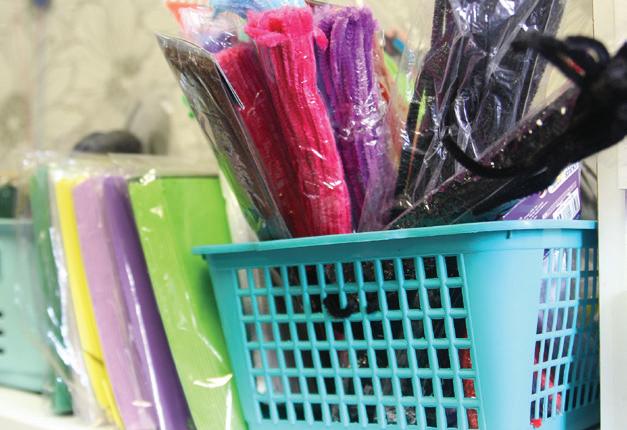






often repeated that it loses its meaning; recycling has become unimportant while the issue of excess waste is becoming worse.
The recycling rate in the Sioux Falls area is on a downward trend, falling below 19 percent in 2024. This “more waste, less recycling” trend has become a global problem, with more than 2 billion tons of solid waste being produced worldwide each year. But if this issue is so big, what can be done about it? One group at LHS has come up with its own answer.
encouraging all students to toss their cans in the recycling bin instead of the garbage. These bins display signs made by the club, which make them easier to spot. Club members will collect the cans from each classroom and bring them to the R & T Unit Can Company, where they will be processed into new
greenhouse, garden outside with donated plants, get out to pick up litter and restart the school thrift store. The club plans to reinvest the money from the cans into its cause, perhaps for the greenhouse or to buy more recycling bins.
The impacts go far beyond the club itself. Their actions are teaching young adults about the influence
by Isabel GIllespIe
“Reduce, reuse, recycle.” We have all heard and seen it a million times: on signs, in commercials, in our schools and above trash cans. But what does it really mean? The phrase is so
The Environmental Ingenuity (EI) Club is making its mission to collect cans from LHS classrooms to be recycled. Recycling bins already exist in the classrooms, but they are often ignored, or garbage gets mixed in, making them relatively


aluminum products and the club will be paid based on the weight. Aluminum is a material that can be recycled many times and retains its quality, which makes it a great focus for repurposing.
“Cans are some of the most recyclable items,” said Grace Werner, Co-chair of the EI club. “It’s 60 days from when you recycle a can to it being back on the shelf as a new can.”
Collecting cans is not the only action step the EI Club is doing for the environment. Werner and students are revitalizing the club after it fell apart last year. They are hoping to get more time in the
they can have on the planet with just a simple action.
“We’re hoping to get students more involved with [recycling], and more mindful when they have trash, putting it in the correct receptacle,” said Werner.
Molly Leuning, a senior at LHS and club president, treasures the club for its initiative and impact.
“Beyond learning how to reduce, reuse and recycle, we get to learn about the environment that surrounds our community and how to take care of it,” said Leuning. “The Earth gives so much to us, and the least we can do is protect and give back to her.”

As only a sophomore in high school, Talia Candor has just moved to the fourth country she has been able to call home.
Candor was born and has lived most of her life in Turkey, but has also resided in the Netherlands, Uzbekistan and now the United States.
Right before the school year started, Candor moved to Sioux Falls because her dad got a job teaching at a university. Right away, her parents knew they wanted her to attend LHS because they heard it is the best high school in the area. So far, Candor has thoroughly enjoyed her experience, both at school and in the city of Sioux Falls.
“I love it here,” said Candor. “[My favorite part] is the people. The people are so kind and cute.”
Candor has noticed that the people she met in the United States have been very welcoming. Whenever she goes to the store or is out
in public, she has random people approach her and start making conversation. She appreciates this because in Turkey, they typically do not try to converse with others they do not know. Coming to a new country, Candor was not expecting the people to be as talkative as they are.
“I thought American people were so cold to talk to. They’re not,” said Candor.
The kindness shown to Candor so far has made it easy for her to make the transition to a new school in a city with strangers. When she first arrived, she was scared because she did not know anyone; now, only a couple of months into the school year, she has made many new friends while still staying in contact with her friends from Turkey.
“I miss them a lot,” said Candor.
Other than the people, Candor admits that there is nothing else she misses back

by Nadia SchNeider, editor-iN-chief

in Turkey. Even coming from Turkey’s capital, Ankara, recreation activities for teenagers in the city are slim. In most of her free time, she would visit malls and attend various concerts. In Sioux Falls, though, there is much more for her to do.
At LHS, Candor is on the cross country team and has competed in several meets already. She enjoys running and how it has provided another way for her to meet new people. In addition to this, she also rows outside of school. She goes to and competes in regattas with her dad, which she has already done during her time in the United States.
Candor has also taken note of how different the schools are in Sioux Falls compared to those in Turkey. This year is her first year doing inperson school since she was in sixth grade, because for three years she did it online. Before that, though, she recalls how she would be in the same
classroom all day long.
“[Here,] you’re walking classroom to classroom,” said Candor. “In Turkey, you’re just staying in the classroom and the teachers are changing.”
Candor likes how she is able to talk to different people and does not have to be in one room with the same people for eight hours every day.
Another difference that Candor has noticed is how Americans celebrate holidays. While in Turkey they still celebrate Christmas, she admits that in the United States, people go all out.
“[Americans] celebrate so crazy,” said Candor. “We’re not like that. We just have a Christmas tree and then presents.”
Candor is looking forward to celebrating other holidays in her new country, such as the Fourth of July. She plans on staying in Sioux Falls for a while and is excited about all the opportunities she is going to have in the future.
deSigN by Nadia SchNeider
SchNeider
Photos are an important part of peoples’ lives. They capture memories that can be treasured forever and can be used as a powerful means of artistic and personal expression. Photographs can even change the world for the better by telling the story of the past. Here at LHS, there is an unsung hero who brings the school to life everyday through his photography.
Ben Schumacher is the Executive Producer for the Sioux Falls School District (SFSD). He takes photos and videos of everything SFSD related, whether it be academics, athletics or the fine arts. Schumacher has been with the school district for over 18 years now, and has had a lot of experiences working with the SFSD.
Schumacher’s passion for photography started at a very young age.
“I got into photography in fourth grade. My parents got my brother and I these cameras that were just a step above a toy, but they had film and all that and I loved them,” said Schumacher.
Schumacher saw this passion grow even more in high school, and it eventually led to him going to Augustana University and majoring in print journalism.
“Right out of college I got an entry-level job at Keloland before eventually becoming a photo journalist,” said Schumacher
After a short time, Schumacher saw an opening to be the Executive Producer for the SFSD and has held that job ever since.
Schumacher always tries to make his photos unique and interesting, despite the fact that he has been taking photos of the same places for 18 years. Whether it be changing the tools he uses or the way he edits, Schumacher invests hours of his own time and effort into his craft, while trying to keep each photo unique.
“That’s the hardest thing: thinking of new ways to tell the same stories over and over,” said Schumacher.
Throughout the years, Scumacher has been behind the scenes at LHS, making memories and strengthening the community, despite often not getting the recognition he deserves. He is one of LHS’s biggest fans and has had a powerful impact on the lives of the students that attend here, even if they may not know his name.
“Ben Schumacher is the epitome of a servant leader,” said LHS band director Drew Balta. “Constantly going out of his way to help others in any way possible, spending long hours on projects that are NOT in the expected responsibilities of his job and always putting the needs for students, teachers and community before his own; Ben is truly one of a kind. [He] can be found at most every SFSD event, most-always behind the scenes, creating media content that can be used to promote student learning, foster student excitement or create memories that teachers and students will have forever.”
